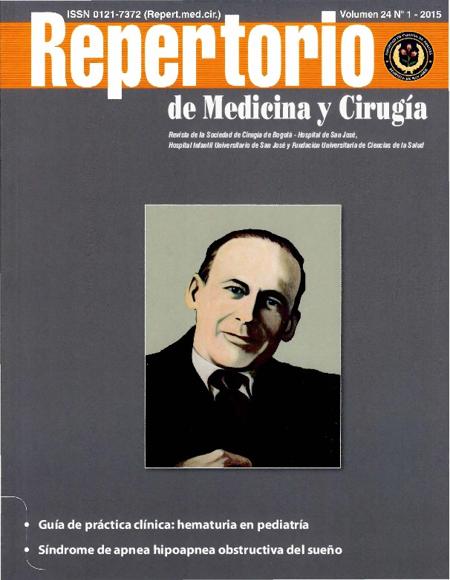Síndrome de apnea hipoapnea obstructiva del sueño en paciente con accidente cerebrovascular isquémico
Obstructive sleep apnea hypopnea syndrome in a patient with ischemic stroke
Cómo citar
Descargar cita
Esta obra está bajo una licencia internacional Creative Commons Atribución-NoComercial-CompartirIgual 4.0.
Mostrar biografía de los autores
El síndrome de apnea hipoapnea obstructiva del sueño es considerado factor de riesgo para accidente cerebrovascular, que es a nivel mundial la segunda causa de muerte y primera de discapacidad. Objetivo: describir la prevalencia de sospecha de SAHOS por escala Epwhort y aumento de circunferencia cervical en pacientes con ACV isquémico en los hospitales de San José e Infantil Universitario de San José, de Bogotá DC, de octubre 2013 a septiembre 30 de 2014. Metodología: estudio descriptivo de corte transversal con población elegida con diagnóstico de ACV isquémico. Resultados: 125 pacientes con edad promedio de 69 años (DE 15.0) y relación hombre/mujer 1:1. Antecedente de SAHOS 1.6% (n: 2). Por Epworth 57% (n: 63/109) tenian sospecha de SAHOS, hombres 60,3%(n: 35). La mediana para Epworth fue 10 (RIQ 7-12). Circunferencia cervical >43 cm en hombres 8,6% (n:5) y en mujeres >40 cm en 28% (n:14). El 30% (19/62) de ACV tenía sospecha de SAHOS por Epworth y circunferencia cervical. Los hombres con Epworth (8-15), tenían circunferencia cervical aumentada 14% (5/35) y las mujeres 51,9% (14/27). La mortalidad intrahospitalaria fue 9,7% (n:12). Conclusión: se encontró que más de la mitad tenía sospecha de SAHOS leve por Epworth. Hubo mayor prevalencia de obesidad cervical en mujeres y una tercera parte tenían sospecha de SAHOS por ambos criterios, lo cual confirma la importancia de explorar de rutina estos indicadores. Abreviaturas: ACV, accidente cerebrovascular; SAHOS, síndrome de apnea hipoapnea del sueño.
Visitas del artículo 422 | Visitas PDF 751
Descargas
1. Dyken ME, Im KB. Obstructive sleep apnea and stroke. Chest. 2009 Dec;136(6):1668-77.
2. Johnson KG, Johnson DC. Frequency of sleep apnea in stroke and TIA patients: a meta-analysis. J Clin Sleep Med. 2010;6(2):131-7.
3. Balami JS, Chen RL, Grunwald IQ, Buchan AM. Neurological complications of acute ischaemic stroke. Lancet Neurol. 2011 Apr;10(4):357-71.
4. Norman D, Loredo JS. Obstructive Sleep Apnea in Older Adults. Clin Geriatr Med. 2008;24(1):151-65.
5. Ho ML, Brass SD. Obstructive sleep apnea. Neurol Int. 2011;3(3):e15.
6. Go AS, Mozaffarian D, Roger VL, Benjamin EJ, Berry JD, Borden WB, et al. Heart disease and stroke statistics--2013 update: a report from the American Heart Association. Circulation. 2013 Jan 1; 127(1):e6-e245.
7. Epstein LJ, Kristo D, Strollo PJ Jr, Friedman N, Malhotra A, Patil SP. Clinical Guideline for the evaluation, management and long-term care of obstructive sleep apnea in adults. J Clin Sleep Med. 2009 Jun 15; 5(3):263-76.
8. Yaggi HK, Concato J, Kernan WN, Lichtman JH, Brass LM, Mohsenin V. Obstructive sleep apnea as a risk factor for stroke and death. N Engl J Med. 2005;353(19):2034-41.
9. Cohen-Zion M, Stepnowsky C, Marler, Shochat T, Kripke DF, Ancoli-Israel S. Changes in cognitive function associated with sleep disordered breathing in older people. J Am Geriatr Soc. 2001; 49(12):1622-7.
10. Chica-Urzola HL, Escobar-Córdoba F, Eslava-Schmalbach J. [Validating the Epworth sleepiness scale]. Rev Salud Publica (Bogota). 2007 Oct-Dec;9(4):558-67.
11. Devulapally K, Pongonis R, Khayat R. OSA: the new cardiovascular disease: part II: Overview of cardiovascular diseases associated with obstructive sleep apnea. Heart Fail Rev. 2009;14(3):155-64.
12. Kuniyoshi FH, Pusalavidyasagar S, Singh P, Somers VK. Cardiovascular consequences of obstructive sleep apnoea. Indian J Med Res. 2010;131:196-205.
13. Birkbak J, Clark AJ, Rod NH. The Effect of Sleep Disordered Breathing on the Outcome of Stroke and Transient Ischemic Attack: A Systematic Review. J Clin Sleep Med.10(1):103-8.
14. Medeiros CA, Bruin VM, Castro-Silva Cd, Araújo SM, Chaves Junior M, Bruin PF.Neck circumference, bedside clinical feature related to mortality of acute ischemic stroke. Rev Assoc Med Bras. 2011 Sep-Oct; 57(5):559-64.
15. Whittle AT, Marshall I, Mortimore IL, Wraith PK, Sellar RJ, Douglas NJ. Neck soft tissue and fat distribution: comparison between normal men and women by magnetic resonanceimaging. Thorax. 1999 Apr; 54(4):323-8.













